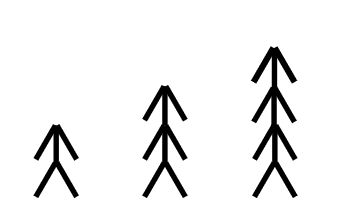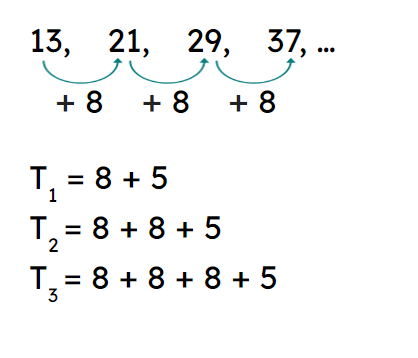Myths about teaching can hold you back


- Year 8
Generating a sequence using a position-to-term rule
I can appreciate that a sequence can be generated and described by a position-to-term rule.


- Year 8
Generating a sequence using a position-to-term rule
I can appreciate that a sequence can be generated and described by a position-to-term rule.
These resources were made for remote use during the pandemic, not classroom teaching.
Switch to our new teaching resources now - designed by teachers and leading subject experts, and tested in classrooms.
Lesson details
Key learning points
- The position of a term in the sequence is its term number.
- The general term can be used to identify a specific term.
- The general term can be used to generate a sequence .
- The general term can be used to generate any number in the sequence.
- The general term can be used to describe a sequence.
Keywords
Position-to-term - A position-to-term rule describes how to generate the term from the term number.
Common misconception
The position-to-term rule is the initial term add the common difference.
Once pupils have found the additive pattern get them to write each term as a value add the difference.
To help you plan your year 8 maths lesson on: Generating a sequence using a position-to-term rule, download all teaching resources for free and adapt to suit your pupils' needs...
To help you plan your year 8 maths lesson on: Generating a sequence using a position-to-term rule, download all teaching resources for free and adapt to suit your pupils' needs.
The starter quiz will activate and check your pupils' prior knowledge, with versions available both with and without answers in PDF format.
We use learning cycles to break down learning into key concepts or ideas linked to the learning outcome. Each learning cycle features explanations with checks for understanding and practice tasks with feedback. All of this is found in our slide decks, ready for you to download and edit. The practice tasks are also available as printable worksheets and some lessons have additional materials with extra material you might need for teaching the lesson.
The assessment exit quiz will test your pupils' understanding of the key learning points.
Our video is a tool for planning, showing how other teachers might teach the lesson, offering helpful tips, modelled explanations and inspiration for your own delivery in the classroom. Plus, you can set it as homework or revision for pupils and keep their learning on track by sharing an online pupil version of this lesson.
Explore more key stage 3 maths lessons from the Sequences unit, dive into the full secondary maths curriculum, or learn more about lesson planning.

Licence
Prior knowledge starter quiz
6 Questions
Q1.A term-to term rule describes how to calculate the next term from....
Q2.True or false. In the sequence 0, 1, 2, 3, 4, ... the 2nd term is 3.
Q3.If the 7 times table start with $$1\times 7 = 7$$ what is the 100th number in the 7 times table?
Q4.Here are the first 3 terms in a pictorial sequence. Which of these rules could refer to the number of lines in each term?

Q5.Which of these is an advantage for using a term-to-term rule
Q6.Match the sequences with the term-to-term rules.
-2, -6, -18, -54, ... -
multiply the previous term by 3
-2, -6, -10, -14, ... -
add $$-4$$ to the previous term
-2, -6, -14, -30, ... -
multiply the previous term by 2 then subtract 2
-2, -6, -12, -20, ... -
add $$-4$$, add $$-6$$, add $$-8$$, ...
-2, -6, -14, -26, ... -
add $$-4$$, add $$-8$$, add $$-12$$, ...
-2, -6, -8, -8, ... -
add $$-4$$, add $$-2$$, add 0, ...
Assessment exit quiz
6 Questions
Q1.Match up the keywords to their definitions
term -
each value or pattern in a sequence
term-to-term rule -
describes how to get from one term to the next
position-to-term rule -
describes how to calculate the term from the term number
sequence -
a succession of values or patterns usually following a rule.
Q2.Using the table shown, match the notation to the term.

$$T_1$$ -
3
$$T_2$$ -
1
$$T_3$$ -
0
$$T_4$$ -
-2
Q3.The position-to-term rule for a sequence is 'multiply the term number by 5 then subtract 10'. What is the 20th term in this sequence?
Q4.Which of these is a position-to-term rule for the number of dots in each pattern of this sequence?

Q5.Which of these is a position-to-term rule for the sequence 12, 22, 32, 42, 52, ....
Q6.Work out the 100th term in the constant additive sequence which starts: 13, 21, 29, 37, ... The first few lines of working are shown.


